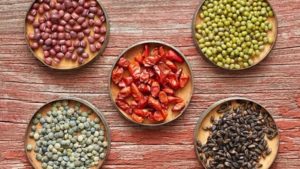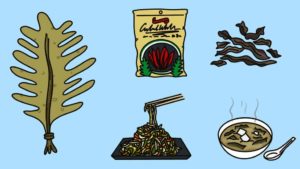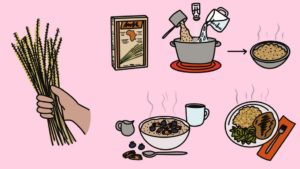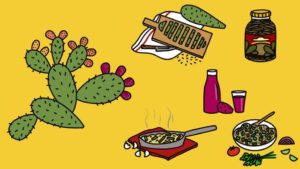There is a saying in Chinese that “people are iron, rice is steel, and a meal is not hungry.” Everyone wants to eat and eat well. But with the increase in the Earth’s population and the reduction of natural resources. What foods can satisfy both health and the need to save the planet?

Rice, corn and wheat are the grains that people are familiar with. Although they are an indispensable staple food for human beings, providing people with 60% of the energy they need, it is obviously not enough to rely on these foods.
A new report by the German food company (Knorr) and the World Wide Fund for Nature (WWF UK) lists 50 “future foods” that are both healthy and environmentally friendly.
The magical effect of kelp, the beautiful island women go to the right to get rich road
How much green is the food and wine? First calculate the carbon footprint
Alternative high-protein foods – sweet and sour crispy and nutritious
Marine pollution: the danger hidden in sushi seaweed seaweed
Here, we introduce you to five of the lesser known “superfoods.”
Moringa

Moringa trees are nutritious and are often referred to as “miracle trees.” This tree is native to South Asia. It grows fast and is drought-resistant, and the whole body is treasure.
The leaves of Moringa tree can be picked 7 times a year, rich in vitamins A and C, as well as calcium and potassium. Usually people use soup directly from Moringa tree leaves. Some people use it to make pancakes.
In the Philippines and Indonesia, people often use the bean clips of the tree to make curry and soup seasonings. The pod is rich in oleic acid, which can improve the level of good cholesterol in the human body.
The leaves of Moringa tree can also be ground into powder for making smoothie, soup, seasoning and tea.
In addition, many parts of Moringa tree can also be made into medicine to treat diseases and treat diseases.
Wakame

Japanese cultured wakame seaweed has been around for hundreds of years. At present, countries such as France, New Zealand and Argentina have also started planting.
The advantage of wakame is that it can be harvested all year round without the use of chemical fertilizers or pesticides. It can be dried in the sun and made into dried seaweed.
The wakame is also rich in omega-3 fatty acids.
At the same time, a brown wakame also contains a large amount of fucoidan. According to animal studies, this dietary fiber has the potential to lower blood pressure, resist blood clotting and even anti-tumor.
Experts say that wakame is an important source of omega-3 fatty acids and iodine, especially for those who don’t eat much meat.
Wakame can be fried, served, soup, and so on.
The only thing to note is that if you eat every day, you must have a small amount, because eating too much can cause iodine excess. At the same time, due to marine pollution, its heavy metal content will also be too high.
African Grain Fonio

Fonio (someone transliterated it into Fonio) is a very old African grain, a bit like Gusmi, also known as couscous.
This grain has a fine mouthfeel and is a bit like a nutty taste. Therefore, delicious and healthy.
The Bambara people of Mali in Mali, Africa, said that it is very easy to make such rice, so even those who do not cook can cope.
There is evidence that the ancient Egyptians had planted Foniomi 5,000 years ago. It is drought-resistant and matures in about 60 or 70 days.
Fonio is rich in iron and magnesium, can be eaten like Gusmi and rice, and can also be used to make beer.
Fonio rice is gluten free, so those who are allergic to gluten or have problems with digestion can safely eat it.
Cactus leaf (Nopales cactus)
The new trend of British diet Crisp and the story of saving the earth
Several harmful environmental daily necessities and fruits and vegetables. See if you have any tricks.
Pet World: A cat and dog “carbon footprint” is bigger than Toyota off-road vehicle
Doomsday food recommendation: turtle meat, potatoes and canned meat
Cactus is a common food in the Mexican diet. It can be eaten raw, cooked, or made into jam or juice.

Cactus plants are grown in Central America, South America, Australia, and Europe.
Some clinical trials have shown that the fibers in cactus can help the body metabolize more fat.
There are also trials that can lower blood sugar and ease hangover discomfort after drinking. But experts say that the results of these tests should be treated with caution.
If you have never eaten a cactus, don’t start it too quickly, because some people may have side effects such as mild diarrhea, nausea and bloating.
Bambara bean

Bambara beans are a bit like peanuts, but sweeter than peanuts and not as oily as peanuts.
Bambara beans can grow in poor soil and make the soil more fertile by releasing nitrogen into the soil.
It is a traditional African bean, but it is also grown and eaten in Thailand and Malaysia.
Cooking methods include boiling, roasting, frying or processing into fine flour.
In East Africa, people like to make Bambara beans into beans and make soup. It is rich in protein and is an important source of the essential amino acid methionine.
Methionine is essential for promoting the growth of new blood vessels and absorbing zinc.
According to the British Nutrition Society’s Pyria Tew (the British Dietetic Association), this is a boon for vegetarians and vegans. Moreover, this crop is highly sustainable and beneficial to the environment.
Other future health foods include sweet potatoes, red beans, lotus roots, soybeans, buckwheat and buckwheat that are familiar to Chinese.


